Management Accounting Systems and Techniques: A Study on Creams Ltd
VerifiedAdded on 2023/01/11
|16
|4493
|33
AI Summary
This study focuses on the management accounting systems and techniques used by Creams Ltd, including inventory management, cost accounting, and job costing. It also discusses the benefits and applications of these systems in resolving financial issues.
Contribute Materials
Your contribution can guide someone’s learning journey. Share your
documents today.
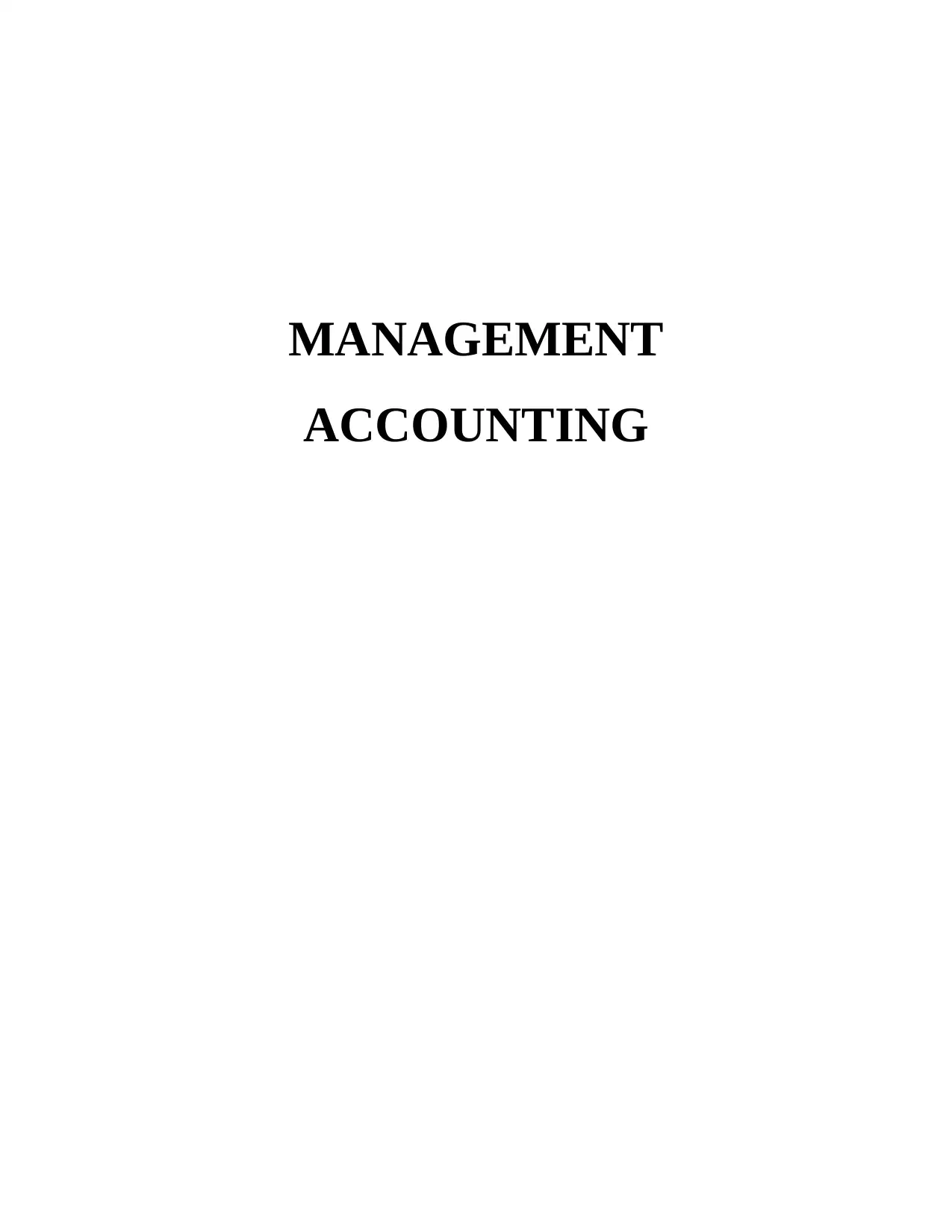
MANAGEMENT
ACCOUNTING
ACCOUNTING
Secure Best Marks with AI Grader
Need help grading? Try our AI Grader for instant feedback on your assignments.
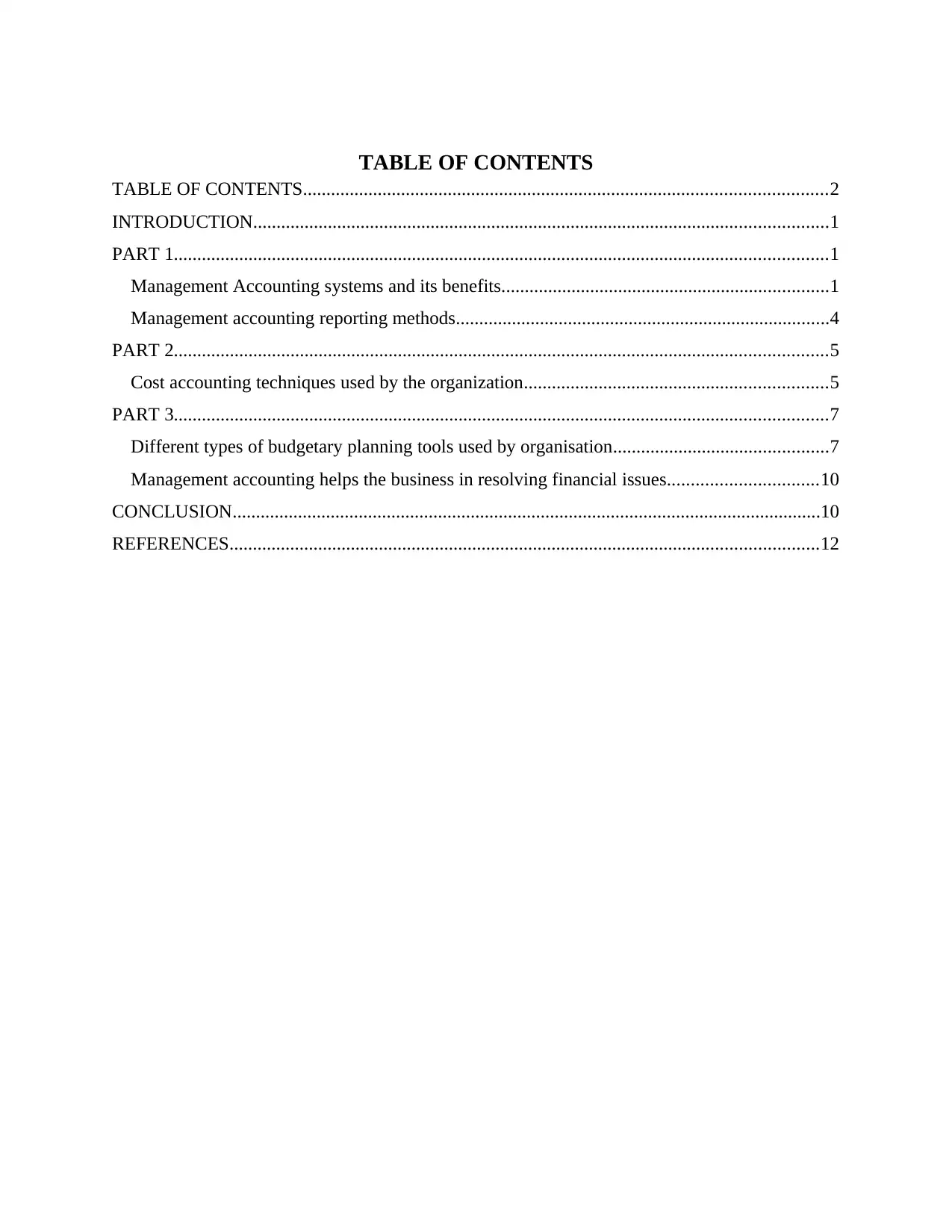
TABLE OF CONTENTS
TABLE OF CONTENTS................................................................................................................2
INTRODUCTION...........................................................................................................................1
PART 1............................................................................................................................................1
Management Accounting systems and its benefits......................................................................1
Management accounting reporting methods................................................................................4
PART 2............................................................................................................................................5
Cost accounting techniques used by the organization.................................................................5
PART 3............................................................................................................................................7
Different types of budgetary planning tools used by organisation..............................................7
Management accounting helps the business in resolving financial issues................................10
CONCLUSION..............................................................................................................................10
REFERENCES..............................................................................................................................12
TABLE OF CONTENTS................................................................................................................2
INTRODUCTION...........................................................................................................................1
PART 1............................................................................................................................................1
Management Accounting systems and its benefits......................................................................1
Management accounting reporting methods................................................................................4
PART 2............................................................................................................................................5
Cost accounting techniques used by the organization.................................................................5
PART 3............................................................................................................................................7
Different types of budgetary planning tools used by organisation..............................................7
Management accounting helps the business in resolving financial issues................................10
CONCLUSION..............................................................................................................................10
REFERENCES..............................................................................................................................12
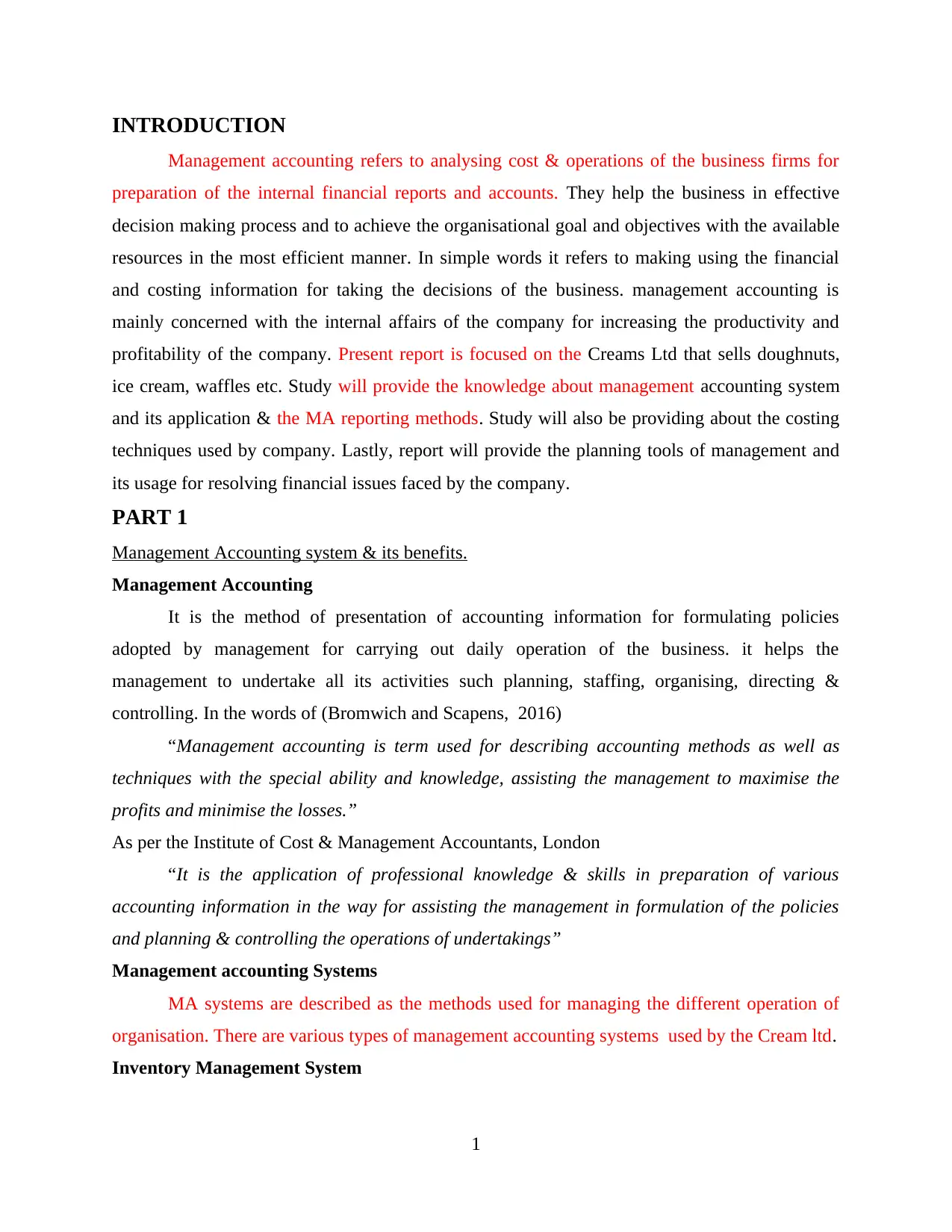
INTRODUCTION
Management accounting refers to analysing cost & operations of the business firms for
preparation of the internal financial reports and accounts. They help the business in effective
decision making process and to achieve the organisational goal and objectives with the available
resources in the most efficient manner. In simple words it refers to making using the financial
and costing information for taking the decisions of the business. management accounting is
mainly concerned with the internal affairs of the company for increasing the productivity and
profitability of the company. Present report is focused on the Creams Ltd that sells doughnuts,
ice cream, waffles etc. Study will provide the knowledge about management accounting system
and its application & the MA reporting methods. Study will also be providing about the costing
techniques used by company. Lastly, report will provide the planning tools of management and
its usage for resolving financial issues faced by the company.
PART 1
Management Accounting system & its benefits.
Management Accounting
It is the method of presentation of accounting information for formulating policies
adopted by management for carrying out daily operation of the business. it helps the
management to undertake all its activities such planning, staffing, organising, directing &
controlling. In the words of (Bromwich and Scapens, 2016)
“Management accounting is term used for describing accounting methods as well as
techniques with the special ability and knowledge, assisting the management to maximise the
profits and minimise the losses.”
As per the Institute of Cost & Management Accountants, London
“It is the application of professional knowledge & skills in preparation of various
accounting information in the way for assisting the management in formulation of the policies
and planning & controlling the operations of undertakings”
Management accounting Systems
MA systems are described as the methods used for managing the different operation of
organisation. There are various types of management accounting systems used by the Cream ltd.
Inventory Management System
1
Management accounting refers to analysing cost & operations of the business firms for
preparation of the internal financial reports and accounts. They help the business in effective
decision making process and to achieve the organisational goal and objectives with the available
resources in the most efficient manner. In simple words it refers to making using the financial
and costing information for taking the decisions of the business. management accounting is
mainly concerned with the internal affairs of the company for increasing the productivity and
profitability of the company. Present report is focused on the Creams Ltd that sells doughnuts,
ice cream, waffles etc. Study will provide the knowledge about management accounting system
and its application & the MA reporting methods. Study will also be providing about the costing
techniques used by company. Lastly, report will provide the planning tools of management and
its usage for resolving financial issues faced by the company.
PART 1
Management Accounting system & its benefits.
Management Accounting
It is the method of presentation of accounting information for formulating policies
adopted by management for carrying out daily operation of the business. it helps the
management to undertake all its activities such planning, staffing, organising, directing &
controlling. In the words of (Bromwich and Scapens, 2016)
“Management accounting is term used for describing accounting methods as well as
techniques with the special ability and knowledge, assisting the management to maximise the
profits and minimise the losses.”
As per the Institute of Cost & Management Accountants, London
“It is the application of professional knowledge & skills in preparation of various
accounting information in the way for assisting the management in formulation of the policies
and planning & controlling the operations of undertakings”
Management accounting Systems
MA systems are described as the methods used for managing the different operation of
organisation. There are various types of management accounting systems used by the Cream ltd.
Inventory Management System
1

Inventory or stock management is described as the method that is used by company for
managing the inventories. Companies are using manual inventory management methods by
combining the technology for the effective management of stocks of the company. Stock
management is used by the organisation for keeping the record of all the inventories that are
coming within the organisations such as raw materials and other input products to the finished
stocks that are sold by the organisation (Otley, 2016). Stock management is required by the
company for keeping the record of raw materials purchased for preparing the ice creams, number
of outputs produced and the amount of output sold and remaining in the company. It uses
different methods of inventory management such as LIFO – This is the method where the goods purchased last are sold for the first by the
entity. Good are sold at the prices by adding profit margin and that is seen generally in
perishable goods. FIFO – It refers to method where the inventory that is purchased first is also sold first.
The method is mostly used by the organisations WAC – This includes the method of using inventory by combining all the inventories
purchased and using the prices of inventory on average basis.
Benefits
Inventory management helps in tracking record of all the inventory movements within
organisation.
This helps in keeping required stock of inventories for the production process. This helps the management in effective decision making by assessing the frequency of
movements.
Application
Stock management is applied by the company for keeping track record of all the
inventories that are produced by the organisation and materials purchased for production.
Cost Accounting Systems
Cost accounting system is of great use to companies for identifying costs involved in
items for the profitability analysis, valuation of inventories and for cost control. This system is
used by company for keeping the complete record of all the activities and operations that are
consuming costs. It accounts for all the variable and fixed costs. Cost accounting systems also
helps organisation in keeping its cost and expenses of the company under control. This is
2
managing the inventories. Companies are using manual inventory management methods by
combining the technology for the effective management of stocks of the company. Stock
management is used by the organisation for keeping the record of all the inventories that are
coming within the organisations such as raw materials and other input products to the finished
stocks that are sold by the organisation (Otley, 2016). Stock management is required by the
company for keeping the record of raw materials purchased for preparing the ice creams, number
of outputs produced and the amount of output sold and remaining in the company. It uses
different methods of inventory management such as LIFO – This is the method where the goods purchased last are sold for the first by the
entity. Good are sold at the prices by adding profit margin and that is seen generally in
perishable goods. FIFO – It refers to method where the inventory that is purchased first is also sold first.
The method is mostly used by the organisations WAC – This includes the method of using inventory by combining all the inventories
purchased and using the prices of inventory on average basis.
Benefits
Inventory management helps in tracking record of all the inventory movements within
organisation.
This helps in keeping required stock of inventories for the production process. This helps the management in effective decision making by assessing the frequency of
movements.
Application
Stock management is applied by the company for keeping track record of all the
inventories that are produced by the organisation and materials purchased for production.
Cost Accounting Systems
Cost accounting system is of great use to companies for identifying costs involved in
items for the profitability analysis, valuation of inventories and for cost control. This system is
used by company for keeping the complete record of all the activities and operations that are
consuming costs. It accounts for all the variable and fixed costs. Cost accounting systems also
helps organisation in keeping its cost and expenses of the company under control. This is
2
Secure Best Marks with AI Grader
Need help grading? Try our AI Grader for instant feedback on your assignments.
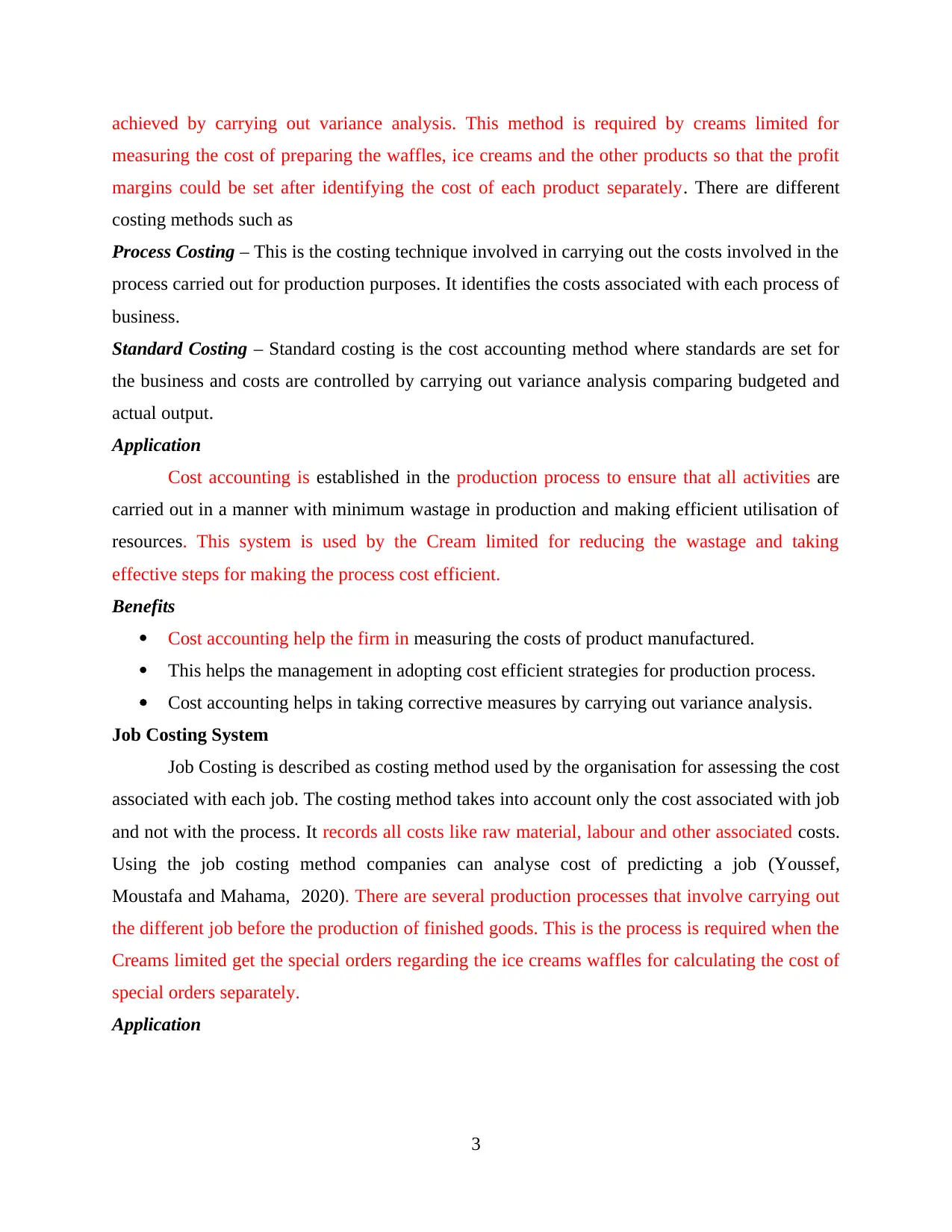
achieved by carrying out variance analysis. This method is required by creams limited for
measuring the cost of preparing the waffles, ice creams and the other products so that the profit
margins could be set after identifying the cost of each product separately. There are different
costing methods such as
Process Costing – This is the costing technique involved in carrying out the costs involved in the
process carried out for production purposes. It identifies the costs associated with each process of
business.
Standard Costing – Standard costing is the cost accounting method where standards are set for
the business and costs are controlled by carrying out variance analysis comparing budgeted and
actual output.
Application
Cost accounting is established in the production process to ensure that all activities are
carried out in a manner with minimum wastage in production and making efficient utilisation of
resources. This system is used by the Cream limited for reducing the wastage and taking
effective steps for making the process cost efficient.
Benefits
Cost accounting help the firm in measuring the costs of product manufactured.
This helps the management in adopting cost efficient strategies for production process.
Cost accounting helps in taking corrective measures by carrying out variance analysis.
Job Costing System
Job Costing is described as costing method used by the organisation for assessing the cost
associated with each job. The costing method takes into account only the cost associated with job
and not with the process. It records all costs like raw material, labour and other associated costs.
Using the job costing method companies can analyse cost of predicting a job (Youssef,
Moustafa and Mahama, 2020). There are several production processes that involve carrying out
the different job before the production of finished goods. This is the process is required when the
Creams limited get the special orders regarding the ice creams waffles for calculating the cost of
special orders separately.
Application
3
measuring the cost of preparing the waffles, ice creams and the other products so that the profit
margins could be set after identifying the cost of each product separately. There are different
costing methods such as
Process Costing – This is the costing technique involved in carrying out the costs involved in the
process carried out for production purposes. It identifies the costs associated with each process of
business.
Standard Costing – Standard costing is the cost accounting method where standards are set for
the business and costs are controlled by carrying out variance analysis comparing budgeted and
actual output.
Application
Cost accounting is established in the production process to ensure that all activities are
carried out in a manner with minimum wastage in production and making efficient utilisation of
resources. This system is used by the Cream limited for reducing the wastage and taking
effective steps for making the process cost efficient.
Benefits
Cost accounting help the firm in measuring the costs of product manufactured.
This helps the management in adopting cost efficient strategies for production process.
Cost accounting helps in taking corrective measures by carrying out variance analysis.
Job Costing System
Job Costing is described as costing method used by the organisation for assessing the cost
associated with each job. The costing method takes into account only the cost associated with job
and not with the process. It records all costs like raw material, labour and other associated costs.
Using the job costing method companies can analyse cost of predicting a job (Youssef,
Moustafa and Mahama, 2020). There are several production processes that involve carrying out
the different job before the production of finished goods. This is the process is required when the
Creams limited get the special orders regarding the ice creams waffles for calculating the cost of
special orders separately.
Application
3
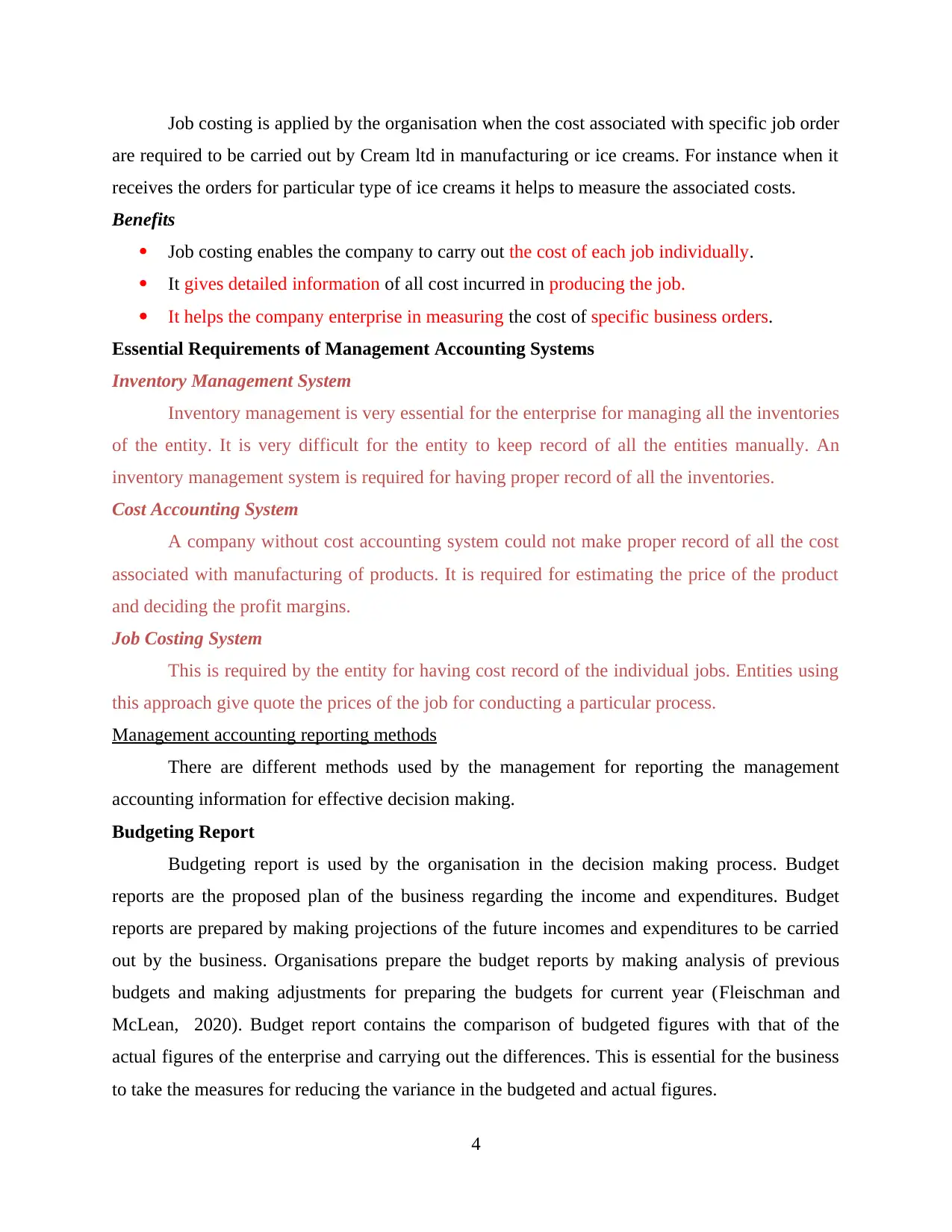
Job costing is applied by the organisation when the cost associated with specific job order
are required to be carried out by Cream ltd in manufacturing or ice creams. For instance when it
receives the orders for particular type of ice creams it helps to measure the associated costs.
Benefits
Job costing enables the company to carry out the cost of each job individually.
It gives detailed information of all cost incurred in producing the job.
It helps the company enterprise in measuring the cost of specific business orders.
Essential Requirements of Management Accounting Systems
Inventory Management System
Inventory management is very essential for the enterprise for managing all the inventories
of the entity. It is very difficult for the entity to keep record of all the entities manually. An
inventory management system is required for having proper record of all the inventories.
Cost Accounting System
A company without cost accounting system could not make proper record of all the cost
associated with manufacturing of products. It is required for estimating the price of the product
and deciding the profit margins.
Job Costing System
This is required by the entity for having cost record of the individual jobs. Entities using
this approach give quote the prices of the job for conducting a particular process.
Management accounting reporting methods
There are different methods used by the management for reporting the management
accounting information for effective decision making.
Budgeting Report
Budgeting report is used by the organisation in the decision making process. Budget
reports are the proposed plan of the business regarding the income and expenditures. Budget
reports are prepared by making projections of the future incomes and expenditures to be carried
out by the business. Organisations prepare the budget reports by making analysis of previous
budgets and making adjustments for preparing the budgets for current year (Fleischman and
McLean, 2020). Budget report contains the comparison of budgeted figures with that of the
actual figures of the enterprise and carrying out the differences. This is essential for the business
to take the measures for reducing the variance in the budgeted and actual figures.
4
are required to be carried out by Cream ltd in manufacturing or ice creams. For instance when it
receives the orders for particular type of ice creams it helps to measure the associated costs.
Benefits
Job costing enables the company to carry out the cost of each job individually.
It gives detailed information of all cost incurred in producing the job.
It helps the company enterprise in measuring the cost of specific business orders.
Essential Requirements of Management Accounting Systems
Inventory Management System
Inventory management is very essential for the enterprise for managing all the inventories
of the entity. It is very difficult for the entity to keep record of all the entities manually. An
inventory management system is required for having proper record of all the inventories.
Cost Accounting System
A company without cost accounting system could not make proper record of all the cost
associated with manufacturing of products. It is required for estimating the price of the product
and deciding the profit margins.
Job Costing System
This is required by the entity for having cost record of the individual jobs. Entities using
this approach give quote the prices of the job for conducting a particular process.
Management accounting reporting methods
There are different methods used by the management for reporting the management
accounting information for effective decision making.
Budgeting Report
Budgeting report is used by the organisation in the decision making process. Budget
reports are the proposed plan of the business regarding the income and expenditures. Budget
reports are prepared by making projections of the future incomes and expenditures to be carried
out by the business. Organisations prepare the budget reports by making analysis of previous
budgets and making adjustments for preparing the budgets for current year (Fleischman and
McLean, 2020). Budget report contains the comparison of budgeted figures with that of the
actual figures of the enterprise and carrying out the differences. This is essential for the business
to take the measures for reducing the variance in the budgeted and actual figures.
4
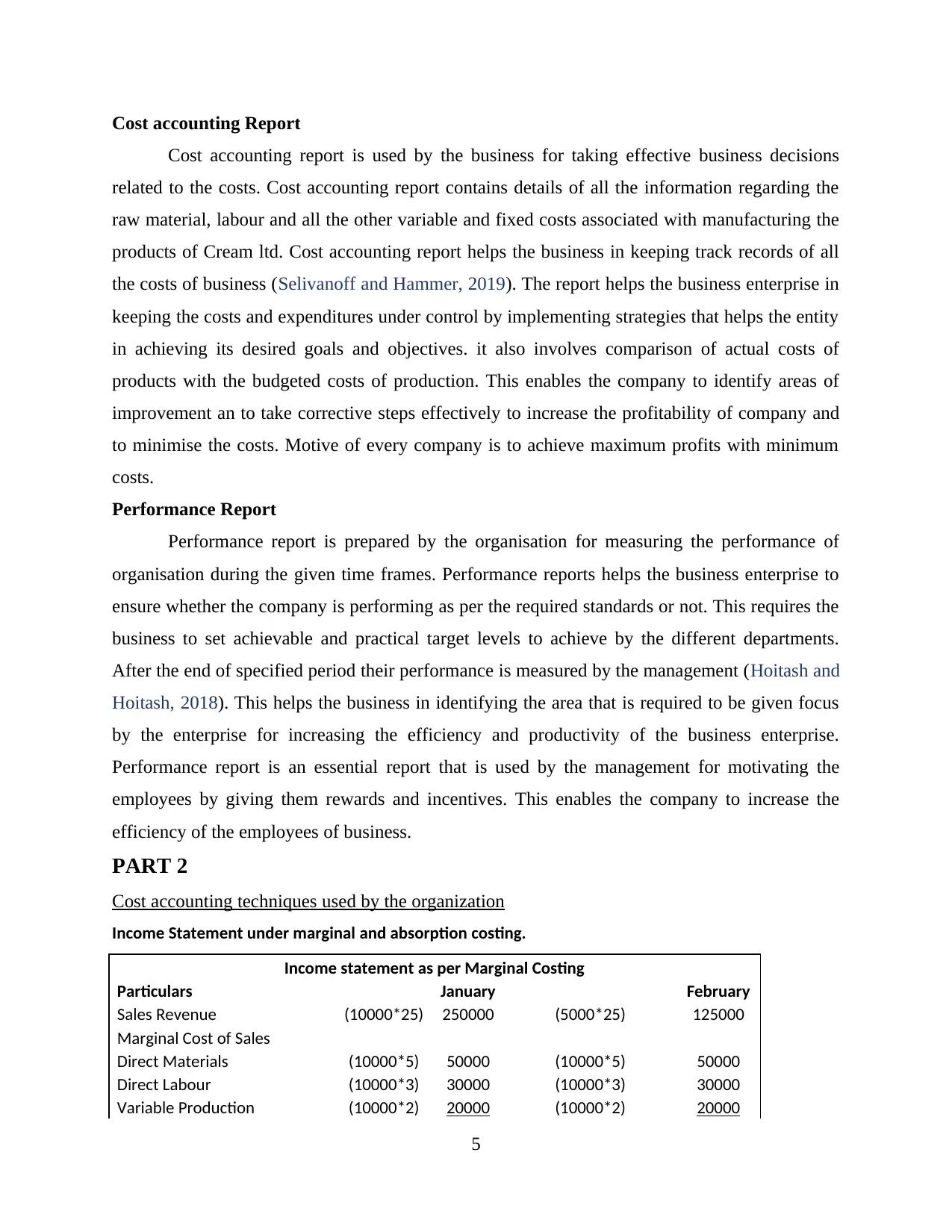
Cost accounting Report
Cost accounting report is used by the business for taking effective business decisions
related to the costs. Cost accounting report contains details of all the information regarding the
raw material, labour and all the other variable and fixed costs associated with manufacturing the
products of Cream ltd. Cost accounting report helps the business in keeping track records of all
the costs of business (Selivanoff and Hammer, 2019). The report helps the business enterprise in
keeping the costs and expenditures under control by implementing strategies that helps the entity
in achieving its desired goals and objectives. it also involves comparison of actual costs of
products with the budgeted costs of production. This enables the company to identify areas of
improvement an to take corrective steps effectively to increase the profitability of company and
to minimise the costs. Motive of every company is to achieve maximum profits with minimum
costs.
Performance Report
Performance report is prepared by the organisation for measuring the performance of
organisation during the given time frames. Performance reports helps the business enterprise to
ensure whether the company is performing as per the required standards or not. This requires the
business to set achievable and practical target levels to achieve by the different departments.
After the end of specified period their performance is measured by the management (Hoitash and
Hoitash, 2018). This helps the business in identifying the area that is required to be given focus
by the enterprise for increasing the efficiency and productivity of the business enterprise.
Performance report is an essential report that is used by the management for motivating the
employees by giving them rewards and incentives. This enables the company to increase the
efficiency of the employees of business.
PART 2
Cost accounting techniques used by the organization
Income Statement under marginal and absorption costing.
Income statement as per Marginal Costing
Particulars January February
Sales Revenue (10000*25) 250000 (5000*25) 125000
Marginal Cost of Sales
Direct Materials (10000*5) 50000 (10000*5) 50000
Direct Labour (10000*3) 30000 (10000*3) 30000
Variable Production (10000*2) 20000 (10000*2) 20000
5
Cost accounting report is used by the business for taking effective business decisions
related to the costs. Cost accounting report contains details of all the information regarding the
raw material, labour and all the other variable and fixed costs associated with manufacturing the
products of Cream ltd. Cost accounting report helps the business in keeping track records of all
the costs of business (Selivanoff and Hammer, 2019). The report helps the business enterprise in
keeping the costs and expenditures under control by implementing strategies that helps the entity
in achieving its desired goals and objectives. it also involves comparison of actual costs of
products with the budgeted costs of production. This enables the company to identify areas of
improvement an to take corrective steps effectively to increase the profitability of company and
to minimise the costs. Motive of every company is to achieve maximum profits with minimum
costs.
Performance Report
Performance report is prepared by the organisation for measuring the performance of
organisation during the given time frames. Performance reports helps the business enterprise to
ensure whether the company is performing as per the required standards or not. This requires the
business to set achievable and practical target levels to achieve by the different departments.
After the end of specified period their performance is measured by the management (Hoitash and
Hoitash, 2018). This helps the business in identifying the area that is required to be given focus
by the enterprise for increasing the efficiency and productivity of the business enterprise.
Performance report is an essential report that is used by the management for motivating the
employees by giving them rewards and incentives. This enables the company to increase the
efficiency of the employees of business.
PART 2
Cost accounting techniques used by the organization
Income Statement under marginal and absorption costing.
Income statement as per Marginal Costing
Particulars January February
Sales Revenue (10000*25) 250000 (5000*25) 125000
Marginal Cost of Sales
Direct Materials (10000*5) 50000 (10000*5) 50000
Direct Labour (10000*3) 30000 (10000*3) 30000
Variable Production (10000*2) 20000 (10000*2) 20000
5
Paraphrase This Document
Need a fresh take? Get an instant paraphrase of this document with our AI Paraphraser
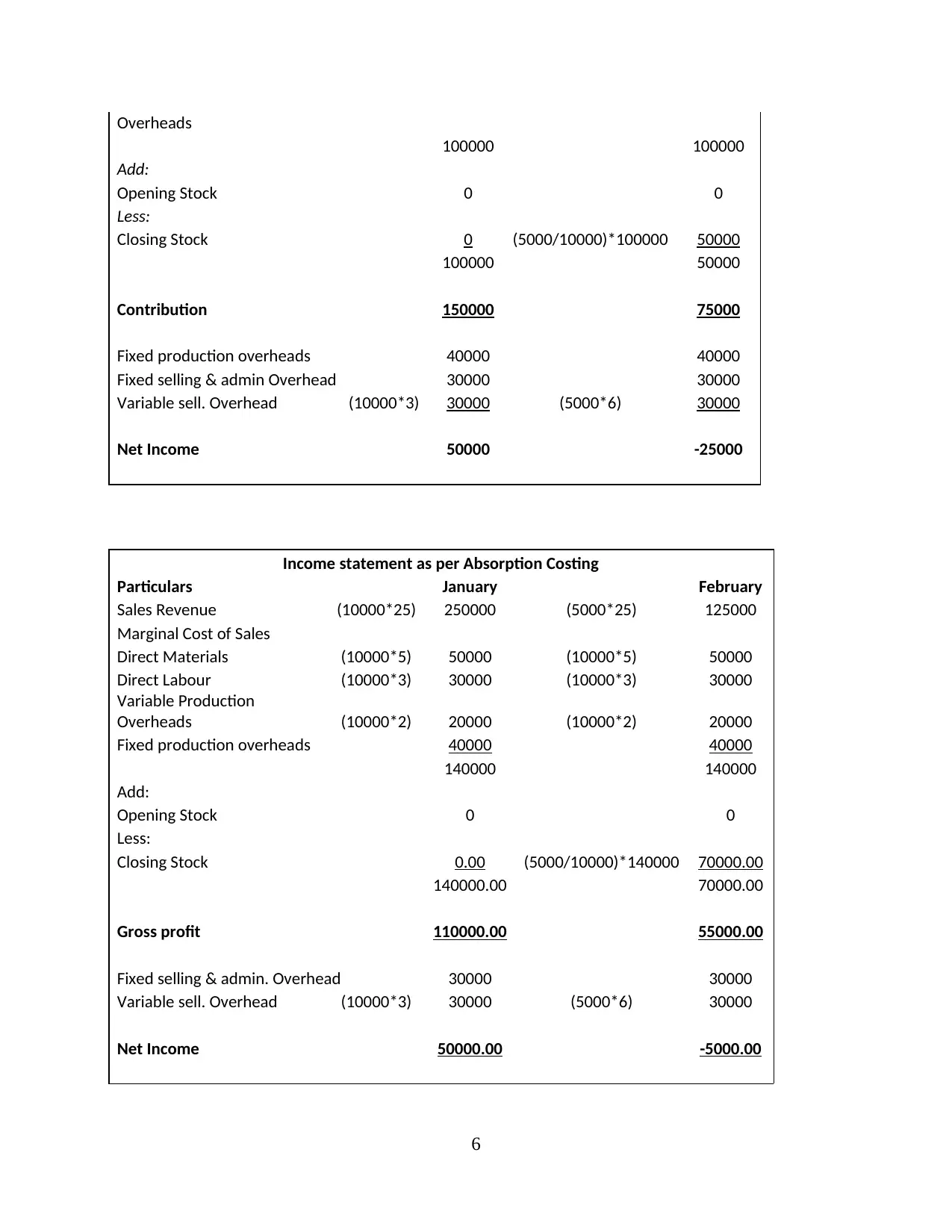
Overheads
100000 100000
Add:
Opening Stock 0 0
Less:
Closing Stock 0 (5000/10000)*100000 50000
100000 50000
Contribution 150000 75000
Fixed production overheads 40000 40000
Fixed selling & admin Overhead 30000 30000
Variable sell. Overhead (10000*3) 30000 (5000*6) 30000
Net Income 50000 -25000
Income statement as per Absorption Costing
Particulars January February
Sales Revenue (10000*25) 250000 (5000*25) 125000
Marginal Cost of Sales
Direct Materials (10000*5) 50000 (10000*5) 50000
Direct Labour (10000*3) 30000 (10000*3) 30000
Variable Production
Overheads (10000*2) 20000 (10000*2) 20000
Fixed production overheads 40000 40000
140000 140000
Add:
Opening Stock 0 0
Less:
Closing Stock 0.00 (5000/10000)*140000 70000.00
140000.00 70000.00
Gross profit 110000.00 55000.00
Fixed selling & admin. Overhead 30000 30000
Variable sell. Overhead (10000*3) 30000 (5000*6) 30000
Net Income 50000.00 -5000.00
6
100000 100000
Add:
Opening Stock 0 0
Less:
Closing Stock 0 (5000/10000)*100000 50000
100000 50000
Contribution 150000 75000
Fixed production overheads 40000 40000
Fixed selling & admin Overhead 30000 30000
Variable sell. Overhead (10000*3) 30000 (5000*6) 30000
Net Income 50000 -25000
Income statement as per Absorption Costing
Particulars January February
Sales Revenue (10000*25) 250000 (5000*25) 125000
Marginal Cost of Sales
Direct Materials (10000*5) 50000 (10000*5) 50000
Direct Labour (10000*3) 30000 (10000*3) 30000
Variable Production
Overheads (10000*2) 20000 (10000*2) 20000
Fixed production overheads 40000 40000
140000 140000
Add:
Opening Stock 0 0
Less:
Closing Stock 0.00 (5000/10000)*140000 70000.00
140000.00 70000.00
Gross profit 110000.00 55000.00
Fixed selling & admin. Overhead 30000 30000
Variable sell. Overhead (10000*3) 30000 (5000*6) 30000
Net Income 50000.00 -5000.00
6
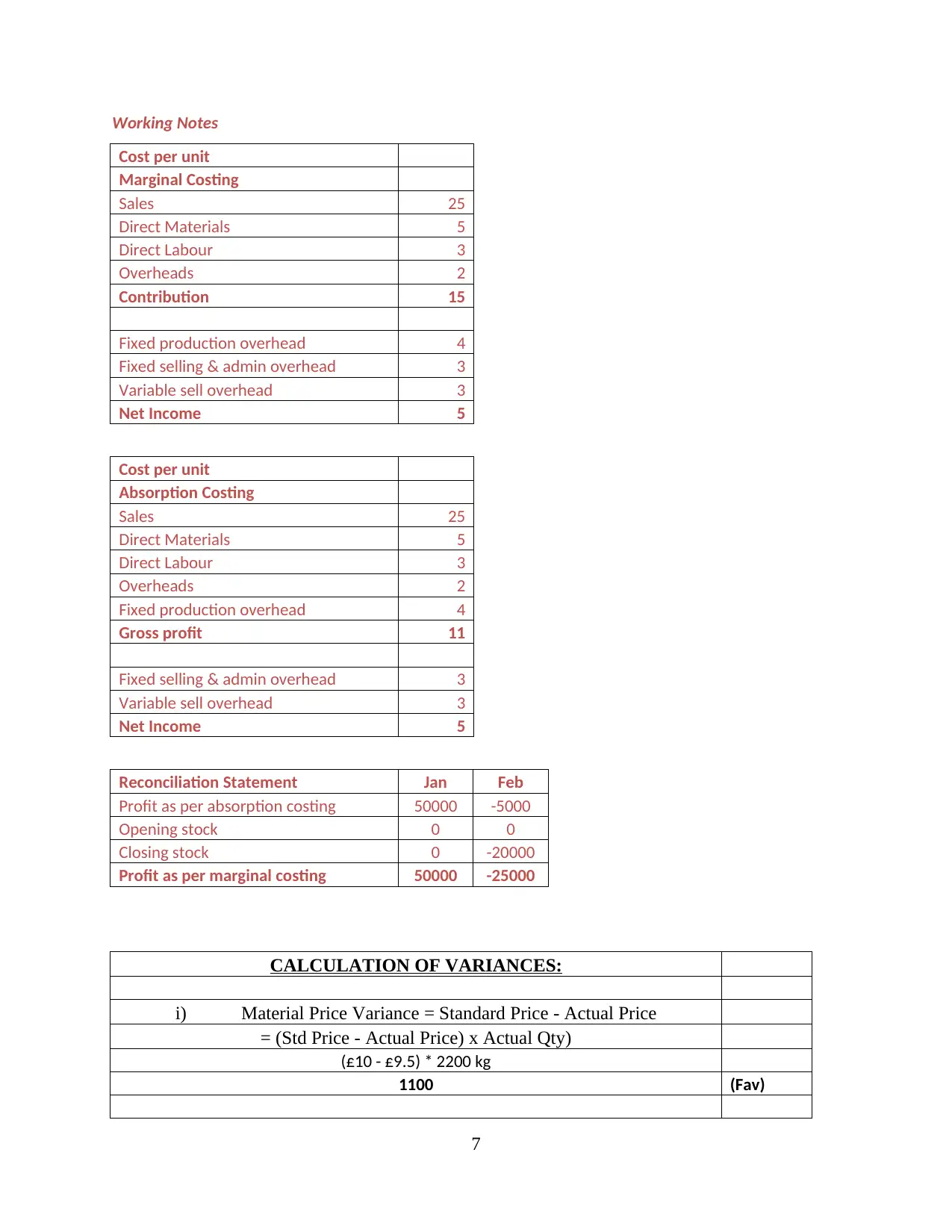
Working Notes
Cost per unit
Marginal Costing
Sales 25
Direct Materials 5
Direct Labour 3
Overheads 2
Contribution 15
Fixed production overhead 4
Fixed selling & admin overhead 3
Variable sell overhead 3
Net Income 5
Cost per unit
Absorption Costing
Sales 25
Direct Materials 5
Direct Labour 3
Overheads 2
Fixed production overhead 4
Gross profit 11
Fixed selling & admin overhead 3
Variable sell overhead 3
Net Income 5
Reconciliation Statement Jan Feb
Profit as per absorption costing 50000 -5000
Opening stock 0 0
Closing stock 0 -20000
Profit as per marginal costing 50000 -25000
CALCULATION OF VARIANCES:
i) Material Price Variance = Standard Price - Actual Price
= (Std Price - Actual Price) x Actual Qty)
(£10 - £9.5) * 2200 kg
1100 (Fav)
7
Cost per unit
Marginal Costing
Sales 25
Direct Materials 5
Direct Labour 3
Overheads 2
Contribution 15
Fixed production overhead 4
Fixed selling & admin overhead 3
Variable sell overhead 3
Net Income 5
Cost per unit
Absorption Costing
Sales 25
Direct Materials 5
Direct Labour 3
Overheads 2
Fixed production overhead 4
Gross profit 11
Fixed selling & admin overhead 3
Variable sell overhead 3
Net Income 5
Reconciliation Statement Jan Feb
Profit as per absorption costing 50000 -5000
Opening stock 0 0
Closing stock 0 -20000
Profit as per marginal costing 50000 -25000
CALCULATION OF VARIANCES:
i) Material Price Variance = Standard Price - Actual Price
= (Std Price - Actual Price) x Actual Qty)
(£10 - £9.5) * 2200 kg
1100 (Fav)
7

i) Material Usage Variance = Standard Usage - Actual Usage
= (Std Qty - Actual Qty) x Std Price)
(2000 kg - 2200 kg) *£10
-2000 (Adv)
Material cost variance = Standard cost – Actual cost
(20000 – 20900) (Adv)
= 900
i) Labour Rate Variance = Standard Rate - Actual Rate
(Std Rate - Actual Rate) x Actual Hours Worked)
( £ 5 -£ 5.2) * 3400
-680 (Adv)
Labour cost variance = Standard cost – Actual cost
(15000 – 17680)
= 2680 (Adv)
Labour Efficiency Variance = (standard hours - Actual hours worked) X Std
Rate
(3000 hrs - 3400 hrs) * £5
-2000 (Adv)
Management Accounting Techniques
Marginal Costing
Marginal Costing refers to the technique that is used by Cream Ltd for calculating the costs of
producing the ice creams. In this costing technique only variable cost associated with the product
are considered where fixed cost are written off against contribution.
Advantages
Marginal costing is simple and easy method of cost calculation.
It enables the company in comparing two products. It is used in decision making by management.
Disadvantages
It does not include the fixed costs of production.
The costing techniques understates profit figures.
Absorption Costing
8
= (Std Qty - Actual Qty) x Std Price)
(2000 kg - 2200 kg) *£10
-2000 (Adv)
Material cost variance = Standard cost – Actual cost
(20000 – 20900) (Adv)
= 900
i) Labour Rate Variance = Standard Rate - Actual Rate
(Std Rate - Actual Rate) x Actual Hours Worked)
( £ 5 -£ 5.2) * 3400
-680 (Adv)
Labour cost variance = Standard cost – Actual cost
(15000 – 17680)
= 2680 (Adv)
Labour Efficiency Variance = (standard hours - Actual hours worked) X Std
Rate
(3000 hrs - 3400 hrs) * £5
-2000 (Adv)
Management Accounting Techniques
Marginal Costing
Marginal Costing refers to the technique that is used by Cream Ltd for calculating the costs of
producing the ice creams. In this costing technique only variable cost associated with the product
are considered where fixed cost are written off against contribution.
Advantages
Marginal costing is simple and easy method of cost calculation.
It enables the company in comparing two products. It is used in decision making by management.
Disadvantages
It does not include the fixed costs of production.
The costing techniques understates profit figures.
Absorption Costing
8
Secure Best Marks with AI Grader
Need help grading? Try our AI Grader for instant feedback on your assignments.
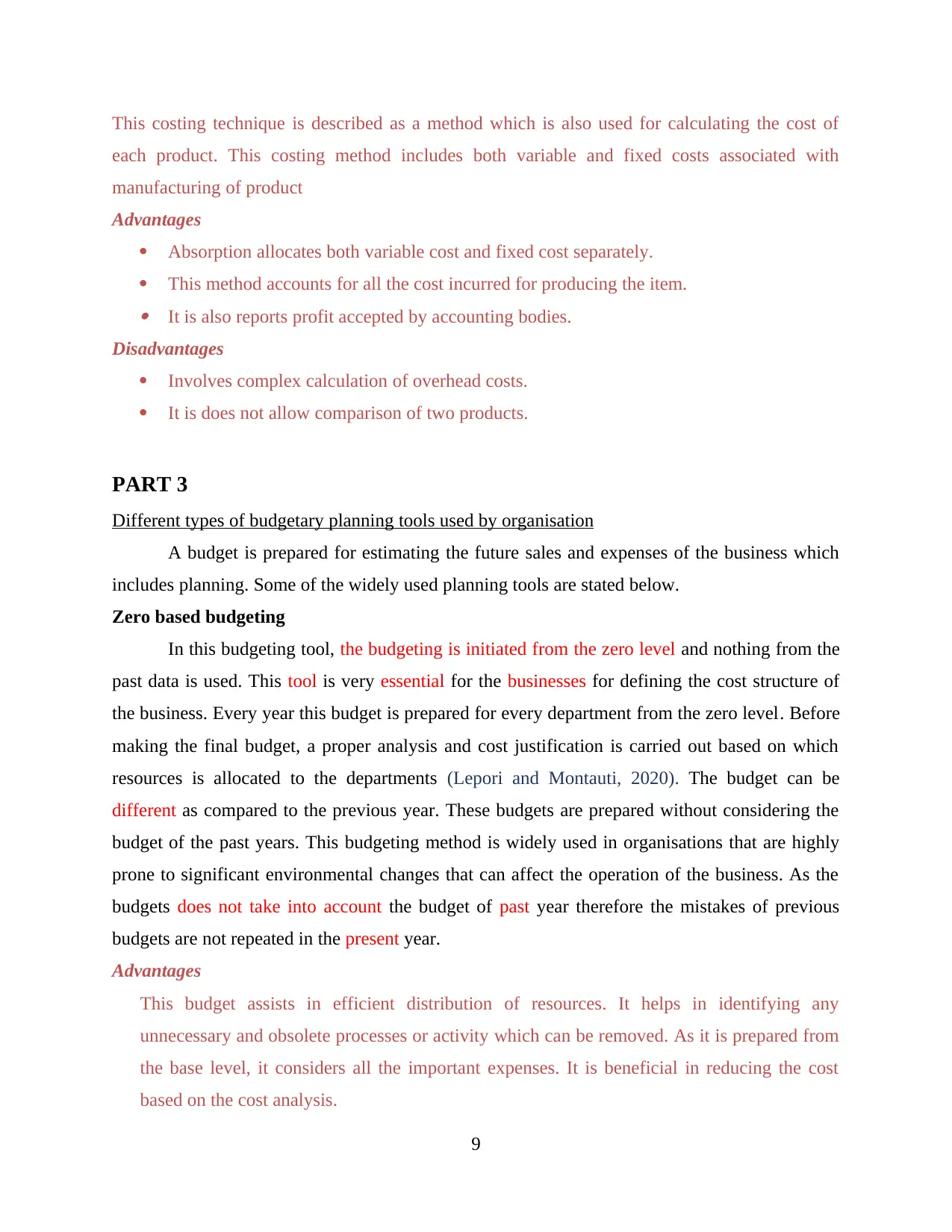
This costing technique is described as a method which is also used for calculating the cost of
each product. This costing method includes both variable and fixed costs associated with
manufacturing of product
Advantages
Absorption allocates both variable cost and fixed cost separately.
This method accounts for all the cost incurred for producing the item. It is also reports profit accepted by accounting bodies.
Disadvantages
Involves complex calculation of overhead costs.
It is does not allow comparison of two products.
PART 3
Different types of budgetary planning tools used by organisation
A budget is prepared for estimating the future sales and expenses of the business which
includes planning. Some of the widely used planning tools are stated below.
Zero based budgeting
In this budgeting tool, the budgeting is initiated from the zero level and nothing from the
past data is used. This tool is very essential for the businesses for defining the cost structure of
the business. Every year this budget is prepared for every department from the zero level. Before
making the final budget, a proper analysis and cost justification is carried out based on which
resources is allocated to the departments (Lepori and Montauti, 2020). The budget can be
different as compared to the previous year. These budgets are prepared without considering the
budget of the past years. This budgeting method is widely used in organisations that are highly
prone to significant environmental changes that can affect the operation of the business. As the
budgets does not take into account the budget of past year therefore the mistakes of previous
budgets are not repeated in the present year.
Advantages
This budget assists in efficient distribution of resources. It helps in identifying any
unnecessary and obsolete processes or activity which can be removed. As it is prepared from
the base level, it considers all the important expenses. It is beneficial in reducing the cost
based on the cost analysis.
9
each product. This costing method includes both variable and fixed costs associated with
manufacturing of product
Advantages
Absorption allocates both variable cost and fixed cost separately.
This method accounts for all the cost incurred for producing the item. It is also reports profit accepted by accounting bodies.
Disadvantages
Involves complex calculation of overhead costs.
It is does not allow comparison of two products.
PART 3
Different types of budgetary planning tools used by organisation
A budget is prepared for estimating the future sales and expenses of the business which
includes planning. Some of the widely used planning tools are stated below.
Zero based budgeting
In this budgeting tool, the budgeting is initiated from the zero level and nothing from the
past data is used. This tool is very essential for the businesses for defining the cost structure of
the business. Every year this budget is prepared for every department from the zero level. Before
making the final budget, a proper analysis and cost justification is carried out based on which
resources is allocated to the departments (Lepori and Montauti, 2020). The budget can be
different as compared to the previous year. These budgets are prepared without considering the
budget of the past years. This budgeting method is widely used in organisations that are highly
prone to significant environmental changes that can affect the operation of the business. As the
budgets does not take into account the budget of past year therefore the mistakes of previous
budgets are not repeated in the present year.
Advantages
This budget assists in efficient distribution of resources. It helps in identifying any
unnecessary and obsolete processes or activity which can be removed. As it is prepared from
the base level, it considers all the important expenses. It is beneficial in reducing the cost
based on the cost analysis.
9
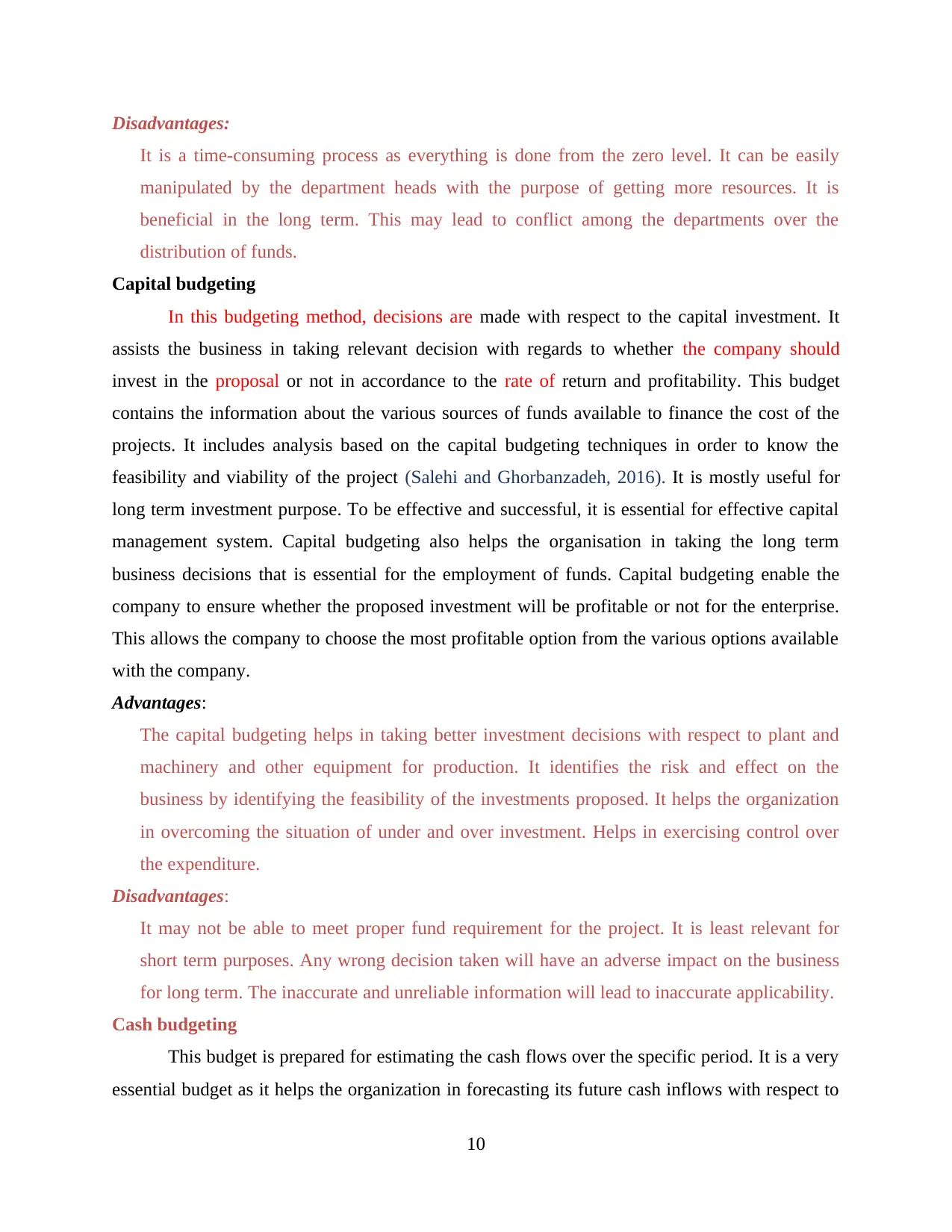
Disadvantages:
It is a time-consuming process as everything is done from the zero level. It can be easily
manipulated by the department heads with the purpose of getting more resources. It is
beneficial in the long term. This may lead to conflict among the departments over the
distribution of funds.
Capital budgeting
In this budgeting method, decisions are made with respect to the capital investment. It
assists the business in taking relevant decision with regards to whether the company should
invest in the proposal or not in accordance to the rate of return and profitability. This budget
contains the information about the various sources of funds available to finance the cost of the
projects. It includes analysis based on the capital budgeting techniques in order to know the
feasibility and viability of the project (Salehi and Ghorbanzadeh, 2016). It is mostly useful for
long term investment purpose. To be effective and successful, it is essential for effective capital
management system. Capital budgeting also helps the organisation in taking the long term
business decisions that is essential for the employment of funds. Capital budgeting enable the
company to ensure whether the proposed investment will be profitable or not for the enterprise.
This allows the company to choose the most profitable option from the various options available
with the company.
Advantages:
The capital budgeting helps in taking better investment decisions with respect to plant and
machinery and other equipment for production. It identifies the risk and effect on the
business by identifying the feasibility of the investments proposed. It helps the organization
in overcoming the situation of under and over investment. Helps in exercising control over
the expenditure.
Disadvantages:
It may not be able to meet proper fund requirement for the project. It is least relevant for
short term purposes. Any wrong decision taken will have an adverse impact on the business
for long term. The inaccurate and unreliable information will lead to inaccurate applicability.
Cash budgeting
This budget is prepared for estimating the cash flows over the specific period. It is a very
essential budget as it helps the organization in forecasting its future cash inflows with respect to
10
It is a time-consuming process as everything is done from the zero level. It can be easily
manipulated by the department heads with the purpose of getting more resources. It is
beneficial in the long term. This may lead to conflict among the departments over the
distribution of funds.
Capital budgeting
In this budgeting method, decisions are made with respect to the capital investment. It
assists the business in taking relevant decision with regards to whether the company should
invest in the proposal or not in accordance to the rate of return and profitability. This budget
contains the information about the various sources of funds available to finance the cost of the
projects. It includes analysis based on the capital budgeting techniques in order to know the
feasibility and viability of the project (Salehi and Ghorbanzadeh, 2016). It is mostly useful for
long term investment purpose. To be effective and successful, it is essential for effective capital
management system. Capital budgeting also helps the organisation in taking the long term
business decisions that is essential for the employment of funds. Capital budgeting enable the
company to ensure whether the proposed investment will be profitable or not for the enterprise.
This allows the company to choose the most profitable option from the various options available
with the company.
Advantages:
The capital budgeting helps in taking better investment decisions with respect to plant and
machinery and other equipment for production. It identifies the risk and effect on the
business by identifying the feasibility of the investments proposed. It helps the organization
in overcoming the situation of under and over investment. Helps in exercising control over
the expenditure.
Disadvantages:
It may not be able to meet proper fund requirement for the project. It is least relevant for
short term purposes. Any wrong decision taken will have an adverse impact on the business
for long term. The inaccurate and unreliable information will lead to inaccurate applicability.
Cash budgeting
This budget is prepared for estimating the cash flows over the specific period. It is a very
essential budget as it helps the organization in forecasting its future cash inflows with respect to
10
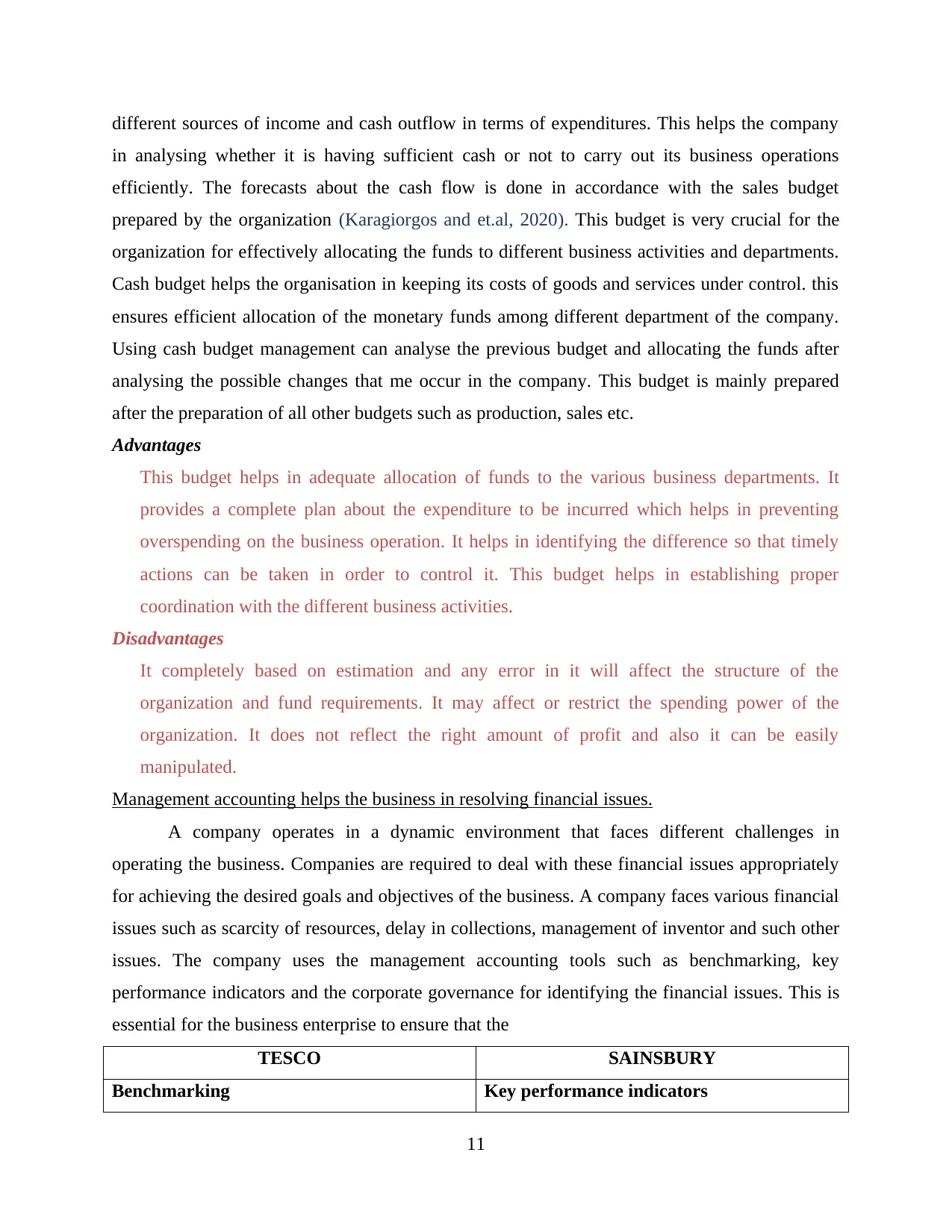
different sources of income and cash outflow in terms of expenditures. This helps the company
in analysing whether it is having sufficient cash or not to carry out its business operations
efficiently. The forecasts about the cash flow is done in accordance with the sales budget
prepared by the organization (Karagiorgos and et.al, 2020). This budget is very crucial for the
organization for effectively allocating the funds to different business activities and departments.
Cash budget helps the organisation in keeping its costs of goods and services under control. this
ensures efficient allocation of the monetary funds among different department of the company.
Using cash budget management can analyse the previous budget and allocating the funds after
analysing the possible changes that me occur in the company. This budget is mainly prepared
after the preparation of all other budgets such as production, sales etc.
Advantages
This budget helps in adequate allocation of funds to the various business departments. It
provides a complete plan about the expenditure to be incurred which helps in preventing
overspending on the business operation. It helps in identifying the difference so that timely
actions can be taken in order to control it. This budget helps in establishing proper
coordination with the different business activities.
Disadvantages
It completely based on estimation and any error in it will affect the structure of the
organization and fund requirements. It may affect or restrict the spending power of the
organization. It does not reflect the right amount of profit and also it can be easily
manipulated.
Management accounting helps the business in resolving financial issues.
A company operates in a dynamic environment that faces different challenges in
operating the business. Companies are required to deal with these financial issues appropriately
for achieving the desired goals and objectives of the business. A company faces various financial
issues such as scarcity of resources, delay in collections, management of inventor and such other
issues. The company uses the management accounting tools such as benchmarking, key
performance indicators and the corporate governance for identifying the financial issues. This is
essential for the business enterprise to ensure that the
TESCO SAINSBURY
Benchmarking Key performance indicators
11
in analysing whether it is having sufficient cash or not to carry out its business operations
efficiently. The forecasts about the cash flow is done in accordance with the sales budget
prepared by the organization (Karagiorgos and et.al, 2020). This budget is very crucial for the
organization for effectively allocating the funds to different business activities and departments.
Cash budget helps the organisation in keeping its costs of goods and services under control. this
ensures efficient allocation of the monetary funds among different department of the company.
Using cash budget management can analyse the previous budget and allocating the funds after
analysing the possible changes that me occur in the company. This budget is mainly prepared
after the preparation of all other budgets such as production, sales etc.
Advantages
This budget helps in adequate allocation of funds to the various business departments. It
provides a complete plan about the expenditure to be incurred which helps in preventing
overspending on the business operation. It helps in identifying the difference so that timely
actions can be taken in order to control it. This budget helps in establishing proper
coordination with the different business activities.
Disadvantages
It completely based on estimation and any error in it will affect the structure of the
organization and fund requirements. It may affect or restrict the spending power of the
organization. It does not reflect the right amount of profit and also it can be easily
manipulated.
Management accounting helps the business in resolving financial issues.
A company operates in a dynamic environment that faces different challenges in
operating the business. Companies are required to deal with these financial issues appropriately
for achieving the desired goals and objectives of the business. A company faces various financial
issues such as scarcity of resources, delay in collections, management of inventor and such other
issues. The company uses the management accounting tools such as benchmarking, key
performance indicators and the corporate governance for identifying the financial issues. This is
essential for the business enterprise to ensure that the
TESCO SAINSBURY
Benchmarking Key performance indicators
11
Paraphrase This Document
Need a fresh take? Get an instant paraphrase of this document with our AI Paraphraser
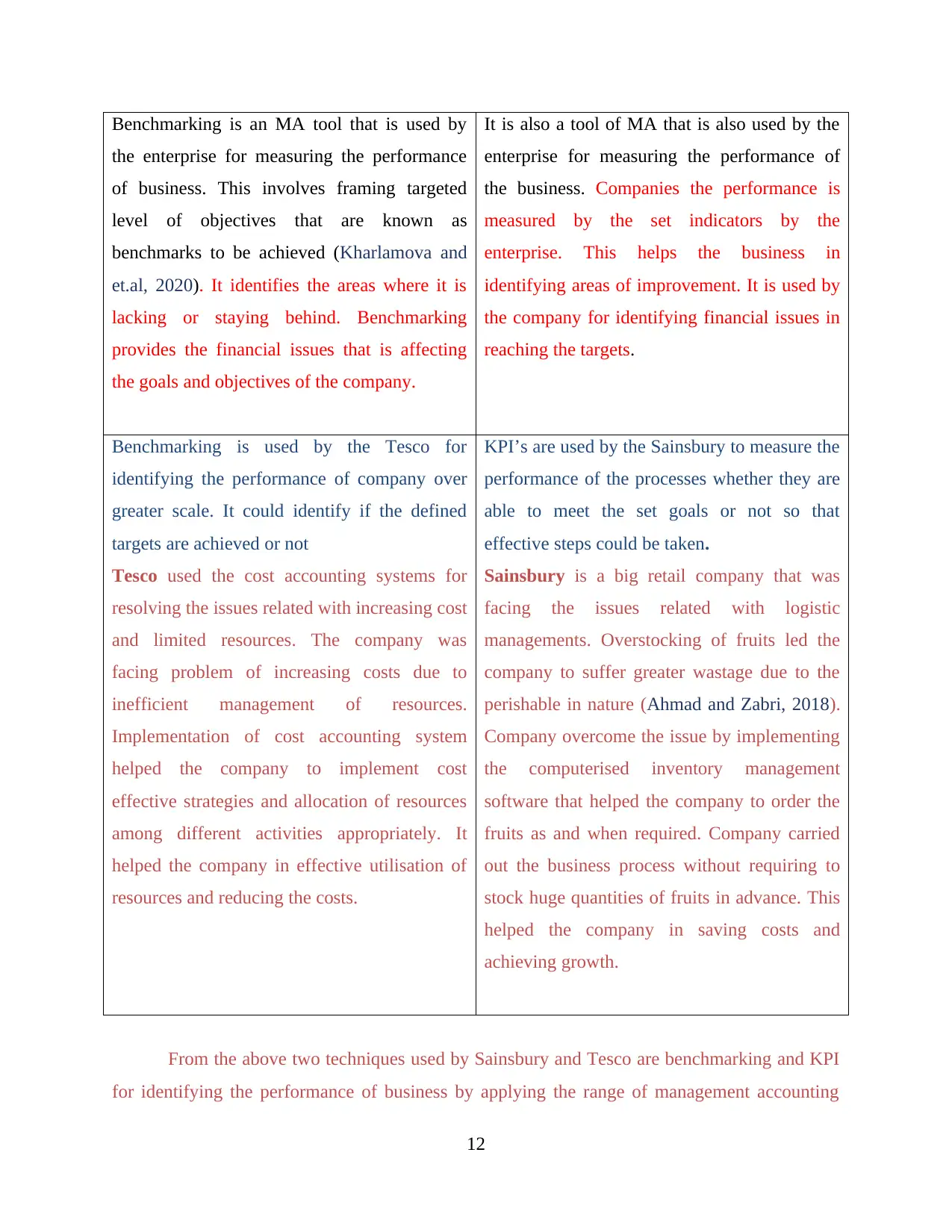
Benchmarking is an MA tool that is used by
the enterprise for measuring the performance
of business. This involves framing targeted
level of objectives that are known as
benchmarks to be achieved (Kharlamova and
et.al, 2020). It identifies the areas where it is
lacking or staying behind. Benchmarking
provides the financial issues that is affecting
the goals and objectives of the company.
It is also a tool of MA that is also used by the
enterprise for measuring the performance of
the business. Companies the performance is
measured by the set indicators by the
enterprise. This helps the business in
identifying areas of improvement. It is used by
the company for identifying financial issues in
reaching the targets.
Benchmarking is used by the Tesco for
identifying the performance of company over
greater scale. It could identify if the defined
targets are achieved or not
Tesco used the cost accounting systems for
resolving the issues related with increasing cost
and limited resources. The company was
facing problem of increasing costs due to
inefficient management of resources.
Implementation of cost accounting system
helped the company to implement cost
effective strategies and allocation of resources
among different activities appropriately. It
helped the company in effective utilisation of
resources and reducing the costs.
KPI’s are used by the Sainsbury to measure the
performance of the processes whether they are
able to meet the set goals or not so that
effective steps could be taken.
Sainsbury is a big retail company that was
facing the issues related with logistic
managements. Overstocking of fruits led the
company to suffer greater wastage due to the
perishable in nature (Ahmad and Zabri, 2018).
Company overcome the issue by implementing
the computerised inventory management
software that helped the company to order the
fruits as and when required. Company carried
out the business process without requiring to
stock huge quantities of fruits in advance. This
helped the company in saving costs and
achieving growth.
From the above two techniques used by Sainsbury and Tesco are benchmarking and KPI
for identifying the performance of business by applying the range of management accounting
12
the enterprise for measuring the performance
of business. This involves framing targeted
level of objectives that are known as
benchmarks to be achieved (Kharlamova and
et.al, 2020). It identifies the areas where it is
lacking or staying behind. Benchmarking
provides the financial issues that is affecting
the goals and objectives of the company.
It is also a tool of MA that is also used by the
enterprise for measuring the performance of
the business. Companies the performance is
measured by the set indicators by the
enterprise. This helps the business in
identifying areas of improvement. It is used by
the company for identifying financial issues in
reaching the targets.
Benchmarking is used by the Tesco for
identifying the performance of company over
greater scale. It could identify if the defined
targets are achieved or not
Tesco used the cost accounting systems for
resolving the issues related with increasing cost
and limited resources. The company was
facing problem of increasing costs due to
inefficient management of resources.
Implementation of cost accounting system
helped the company to implement cost
effective strategies and allocation of resources
among different activities appropriately. It
helped the company in effective utilisation of
resources and reducing the costs.
KPI’s are used by the Sainsbury to measure the
performance of the processes whether they are
able to meet the set goals or not so that
effective steps could be taken.
Sainsbury is a big retail company that was
facing the issues related with logistic
managements. Overstocking of fruits led the
company to suffer greater wastage due to the
perishable in nature (Ahmad and Zabri, 2018).
Company overcome the issue by implementing
the computerised inventory management
software that helped the company to order the
fruits as and when required. Company carried
out the business process without requiring to
stock huge quantities of fruits in advance. This
helped the company in saving costs and
achieving growth.
From the above two techniques used by Sainsbury and Tesco are benchmarking and KPI
for identifying the performance of business by applying the range of management accounting
12

systems. Company could use benchmarking resolving the financial issues faced in meeting the
financial issue related with effective utilisation of the resources. it could set benchmarks and
identify the level of success achieved using the management accounting systems.
CONCLUSION
From above research it could be concluded the MA concepts and techniques helps the
organisation in decision making. MA system helps in efficient management of operations and the
reporting method in effective decision making for implementing the strategies. Companies are
able their able to solve their financial issues with the help of different planning tools and MA
accounting systems. The management accounting concepts and techniques are helping the
organisation to achieve sustainable growth and success of the organisations. The costing
techniques provide the management to use the most appropriate techniques of recording the
costing transactions.
13
financial issue related with effective utilisation of the resources. it could set benchmarks and
identify the level of success achieved using the management accounting systems.
CONCLUSION
From above research it could be concluded the MA concepts and techniques helps the
organisation in decision making. MA system helps in efficient management of operations and the
reporting method in effective decision making for implementing the strategies. Companies are
able their able to solve their financial issues with the help of different planning tools and MA
accounting systems. The management accounting concepts and techniques are helping the
organisation to achieve sustainable growth and success of the organisations. The costing
techniques provide the management to use the most appropriate techniques of recording the
costing transactions.
13
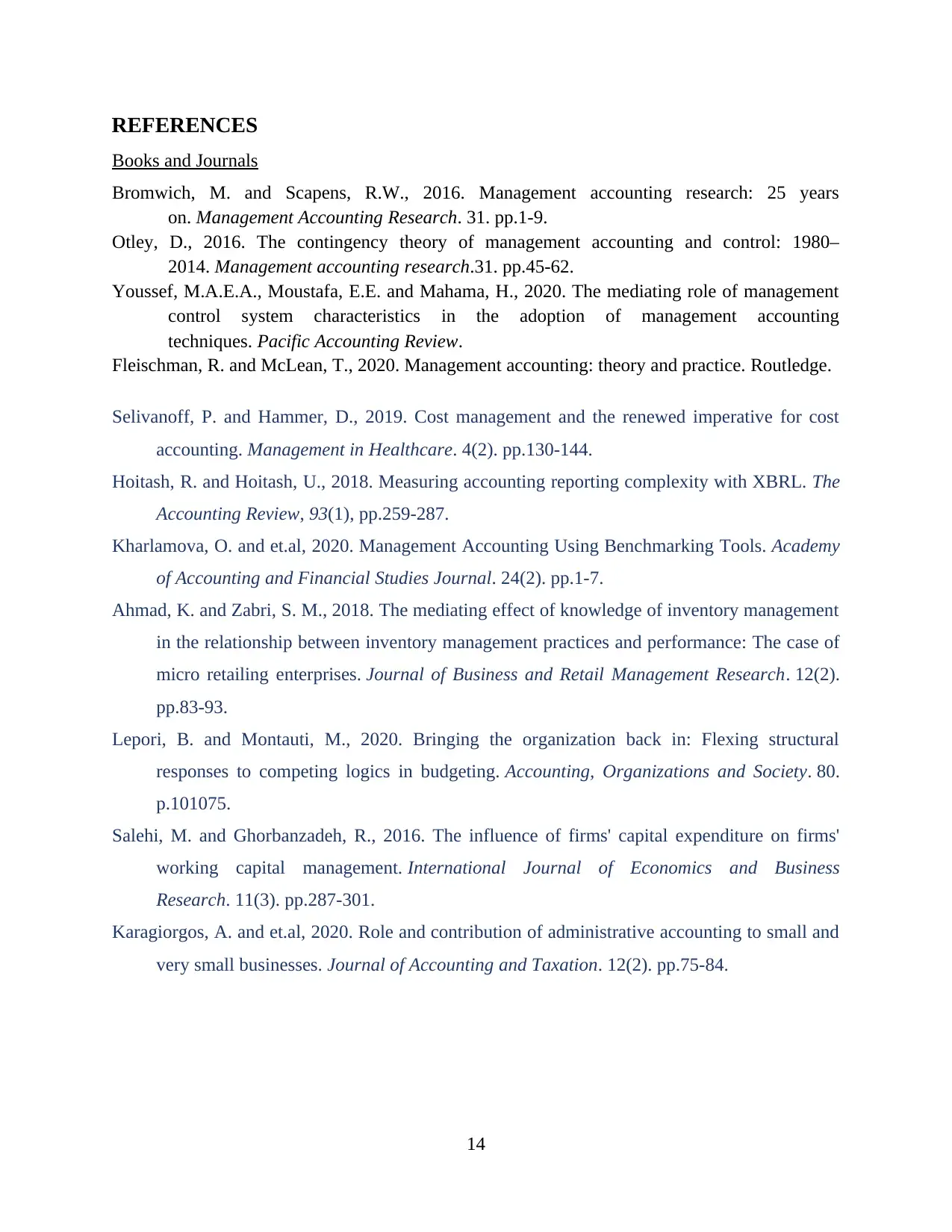
REFERENCES
Books and Journals
Bromwich, M. and Scapens, R.W., 2016. Management accounting research: 25 years
on. Management Accounting Research. 31. pp.1-9.
Otley, D., 2016. The contingency theory of management accounting and control: 1980–
2014. Management accounting research.31. pp.45-62.
Youssef, M.A.E.A., Moustafa, E.E. and Mahama, H., 2020. The mediating role of management
control system characteristics in the adoption of management accounting
techniques. Pacific Accounting Review.
Fleischman, R. and McLean, T., 2020. Management accounting: theory and practice. Routledge.
Selivanoff, P. and Hammer, D., 2019. Cost management and the renewed imperative for cost
accounting. Management in Healthcare. 4(2). pp.130-144.
Hoitash, R. and Hoitash, U., 2018. Measuring accounting reporting complexity with XBRL. The
Accounting Review, 93(1), pp.259-287.
Kharlamova, O. and et.al, 2020. Management Accounting Using Benchmarking Tools. Academy
of Accounting and Financial Studies Journal. 24(2). pp.1-7.
Ahmad, K. and Zabri, S. M., 2018. The mediating effect of knowledge of inventory management
in the relationship between inventory management practices and performance: The case of
micro retailing enterprises. Journal of Business and Retail Management Research. 12(2).
pp.83-93.
Lepori, B. and Montauti, M., 2020. Bringing the organization back in: Flexing structural
responses to competing logics in budgeting. Accounting, Organizations and Society. 80.
p.101075.
Salehi, M. and Ghorbanzadeh, R., 2016. The influence of firms' capital expenditure on firms'
working capital management. International Journal of Economics and Business
Research. 11(3). pp.287-301.
Karagiorgos, A. and et.al, 2020. Role and contribution of administrative accounting to small and
very small businesses. Journal of Accounting and Taxation. 12(2). pp.75-84.
14
Books and Journals
Bromwich, M. and Scapens, R.W., 2016. Management accounting research: 25 years
on. Management Accounting Research. 31. pp.1-9.
Otley, D., 2016. The contingency theory of management accounting and control: 1980–
2014. Management accounting research.31. pp.45-62.
Youssef, M.A.E.A., Moustafa, E.E. and Mahama, H., 2020. The mediating role of management
control system characteristics in the adoption of management accounting
techniques. Pacific Accounting Review.
Fleischman, R. and McLean, T., 2020. Management accounting: theory and practice. Routledge.
Selivanoff, P. and Hammer, D., 2019. Cost management and the renewed imperative for cost
accounting. Management in Healthcare. 4(2). pp.130-144.
Hoitash, R. and Hoitash, U., 2018. Measuring accounting reporting complexity with XBRL. The
Accounting Review, 93(1), pp.259-287.
Kharlamova, O. and et.al, 2020. Management Accounting Using Benchmarking Tools. Academy
of Accounting and Financial Studies Journal. 24(2). pp.1-7.
Ahmad, K. and Zabri, S. M., 2018. The mediating effect of knowledge of inventory management
in the relationship between inventory management practices and performance: The case of
micro retailing enterprises. Journal of Business and Retail Management Research. 12(2).
pp.83-93.
Lepori, B. and Montauti, M., 2020. Bringing the organization back in: Flexing structural
responses to competing logics in budgeting. Accounting, Organizations and Society. 80.
p.101075.
Salehi, M. and Ghorbanzadeh, R., 2016. The influence of firms' capital expenditure on firms'
working capital management. International Journal of Economics and Business
Research. 11(3). pp.287-301.
Karagiorgos, A. and et.al, 2020. Role and contribution of administrative accounting to small and
very small businesses. Journal of Accounting and Taxation. 12(2). pp.75-84.
14
1 out of 16
Related Documents
Your All-in-One AI-Powered Toolkit for Academic Success.
+13062052269
info@desklib.com
Available 24*7 on WhatsApp / Email
![[object Object]](/_next/static/media/star-bottom.7253800d.svg)
Unlock your academic potential
© 2024 | Zucol Services PVT LTD | All rights reserved.





